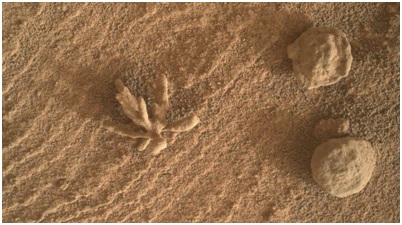

8th March 2022 (5 Topics)
Context
NASA's curiosity rover recently snapped a close-up image of a tiny, flower-like mineral deposit on the surface of Mars.
About
About the new ‘mineral flower’ on Mars:
- The beautiful branching rock is just 0.4 inch (1 centimeter) wide.
- It looks a bit like a coral or a sponge. Despite its likeness to a living organism, however, the deposit is not alive and is a fairly common sight across the Martian landscape.
- Curiosity snapped a picture of the tiny mineral flower near Aeolis Mons, also known as Mount Sharp, at the heart of the 96-mile-wide (154 kilometers) Gale crater.
- The rover has been studying it since its arrival on the Red Planet in 2012.
- The flower-like rock, which has been named the Blackthorn Salt, is a diagenetic feature, or one made from minerals that precipitated from ancient water that had previously been mixed with Martian rock.
- Diagenetic features found on Mars are similar in size but can have either a branched shape, also known as dendritic form, like the Blackthorn Salt, or be more rounded or even spherical, like other rocks in the same photo.
- In 2015, several other flower-like deposits were discovered in the Pahrump Hills area, and in 2019, other diagenetic features were found at the Murray formation.

About Curiosity Rover:
- The Mars Science Laboratory and its rover centerpiece, Curiosity, is the most ambitious Mars mission yet flown by NASA.
- The rover landed on Mars in 2012 with a primary mission to find out if Mars is, or was, suitable for life.
- Another objective is to learn more about the Red Planet's environment.
- In March 2018, it celebrated 2,000 sols (Mars days) on the planet, making its way from Gale Crater to Aeolis Mons (colloquially called Mount Sharp), where it has looked at geological information embedded in the mountain's layers.
- Along the way, it also has found extensive evidence of past water and geological change.
- According to NASA, Curiosity has four main science goalsin support of the agency's Mars exploration program:
- Determine whether life ever arose on Mars.
- Characterize the climate of Mars.
- Characterize the geology of Mars.
- Prepare for human exploration.

More Articles



